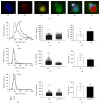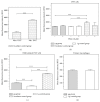Regulation of ICAM-1 in cells of the monocyte/macrophage system in microgravity
- PMID: 25654110
- PMCID: PMC4309248
- DOI: 10.1155/2015/538786
Regulation of ICAM-1 in cells of the monocyte/macrophage system in microgravity
Abstract
Cells of the immune system are highly sensitive to altered gravity, and the monocyte as well as the macrophage function is proven to be impaired under microgravity conditions. In our study, we investigated the surface expression of ICAM-1 protein and expression of ICAM-1 mRNA in cells of the monocyte/macrophage system in microgravity during clinostat, parabolic flight, sounding rocket, and orbital experiments. In murine BV-2 microglial cells, we detected a downregulation of ICAM-1 expression in clinorotation experiments and a rapid and reversible downregulation in the microgravity phase of parabolic flight experiments. In contrast, ICAM-1 expression increased in macrophage-like differentiated human U937 cells during the microgravity phase of parabolic flights and in long-term microgravity provided by a 2D clinostat or during the orbital SIMBOX/Shenzhou-8 mission. In nondifferentiated U937 cells, no effect of microgravity on ICAM-1 expression could be observed during parabolic flight experiments. We conclude that disturbed immune function in microgravity could be a consequence of ICAM-1 modulation in the monocyte/macrophage system, which in turn could have a strong impact on the interaction with T lymphocytes and cell migration. Thus, ICAM-1 can be considered as a rapid-reacting and sustained gravity-regulated molecule in mammalian cells.
Figures







Similar articles
-
Cytoskeletal stability and metabolic alterations in primary human macrophages in long-term microgravity.PLoS One. 2017 Apr 18;12(4):e0175599. doi: 10.1371/journal.pone.0175599. eCollection 2017. PLoS One. 2017. PMID: 28419128 Free PMC article.
-
Cell-to-cell interactions in changed gravity: ground-based and flight experiments.Acta Astronaut. 2005 Jul-Oct;57(2-8):67-74. doi: 10.1016/j.actaastro.2005.03.012. Acta Astronaut. 2005. PMID: 16010753
-
Signal transduction in primary human T lymphocytes in altered gravity during parabolic flight and clinostat experiments.Cell Physiol Biochem. 2015;35(3):1034-51. doi: 10.1159/000373930. Epub 2015 Feb 2. Cell Physiol Biochem. 2015. PMID: 25661802
-
Activation and proliferation of lymphocytes and other mammalian cells in microgravity.Adv Space Biol Med. 1997;6:33-79. doi: 10.1016/s1569-2574(08)60077-5. Adv Space Biol Med. 1997. PMID: 9048133 Review.
-
Ground-based experiments complement microgravity flight opportunities in the investigation of the effects of space flight on the immune response: is protein kinase C gravity sensitive?Trans Kans Acad Sci. 1993 Apr;96(1-2):74-9. Trans Kans Acad Sci. 1993. PMID: 11537715 Review.
Cited by
-
Dynamic gene expression response to altered gravity in human T cells.Sci Rep. 2017 Jul 12;7(1):5204. doi: 10.1038/s41598-017-05580-x. Sci Rep. 2017. PMID: 28701719 Free PMC article.
-
Transcriptional Homeostasis of Oxidative Stress-Related Pathways in Altered Gravity.Int J Mol Sci. 2018 Sep 18;19(9):2814. doi: 10.3390/ijms19092814. Int J Mol Sci. 2018. PMID: 30231541 Free PMC article.
-
Microglial activation in spaceflight and microgravity: potential risk of cognitive dysfunction and poor neural health.Front Cell Neurosci. 2024 Feb 15;18:1296205. doi: 10.3389/fncel.2024.1296205. eCollection 2024. Front Cell Neurosci. 2024. PMID: 38425432 Free PMC article. Review.
-
Neutrophil-modulated Dicer expression in macrophages influences inflammation resolution.Cell Mol Life Sci. 2025 Mar 13;82(1):114. doi: 10.1007/s00018-025-05644-6. Cell Mol Life Sci. 2025. PMID: 40074991 Free PMC article.
-
Omics Studies of Specialized Cells and Stem Cells under Microgravity Conditions.Int J Mol Sci. 2024 Sep 17;25(18):10014. doi: 10.3390/ijms251810014. Int J Mol Sci. 2024. PMID: 39337501 Free PMC article. Review.
References
-
- Ullrich O., Thiel C. S. Gravitational force: triggered stress in cells of the immune system. In: Choukèr A., editor. Stress Challenges, and Immunity in Space: From Mechanisms to Monitoring and Preventive Strategies. chapter 14. Berlin, Germany: Springer; 2012. pp. 187–202. - DOI
-
- Konstantinova I. V., Antropova E. N., Legen'kov V. I., Zazhireĭ V. D. Reactivity of lymphoid blood cells in the crew of “Soiuz-6”, “Soiuz-7” and “Soiuz-8” spacecraft before and after flight. Kosmicheskaia Biologiia i Aviakosmicheskaia Meditsina. 1973;7(6):35–40. - PubMed
Publication types
MeSH terms
Substances
LinkOut - more resources
Full Text Sources
Other Literature Sources
Miscellaneous

